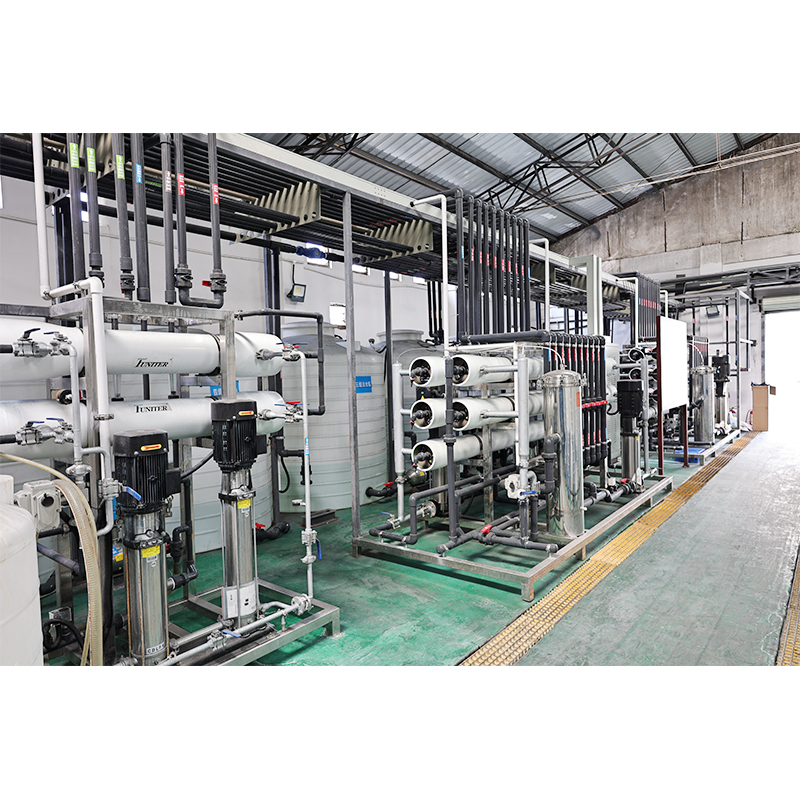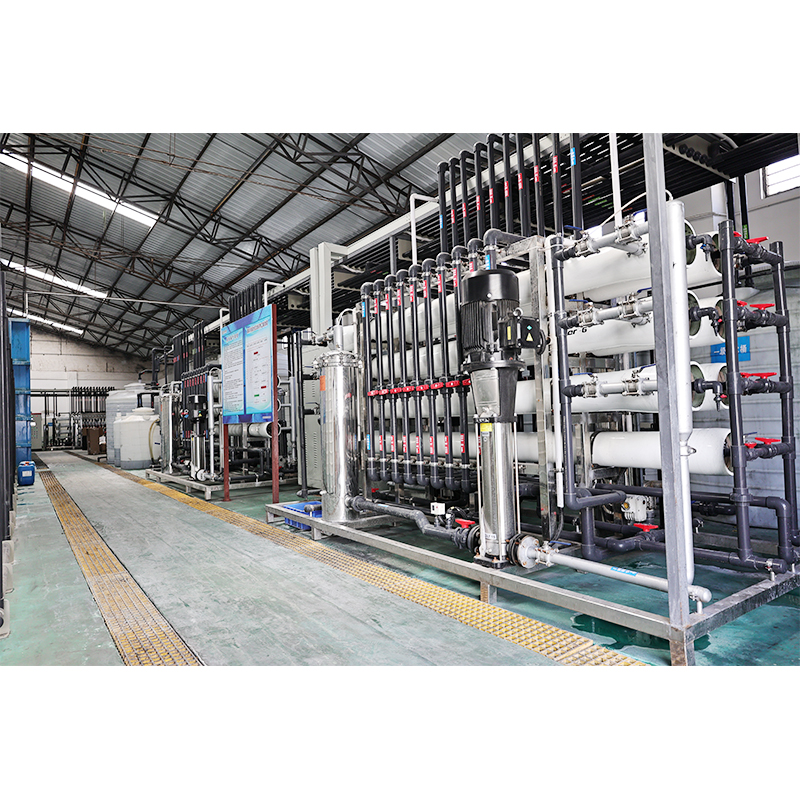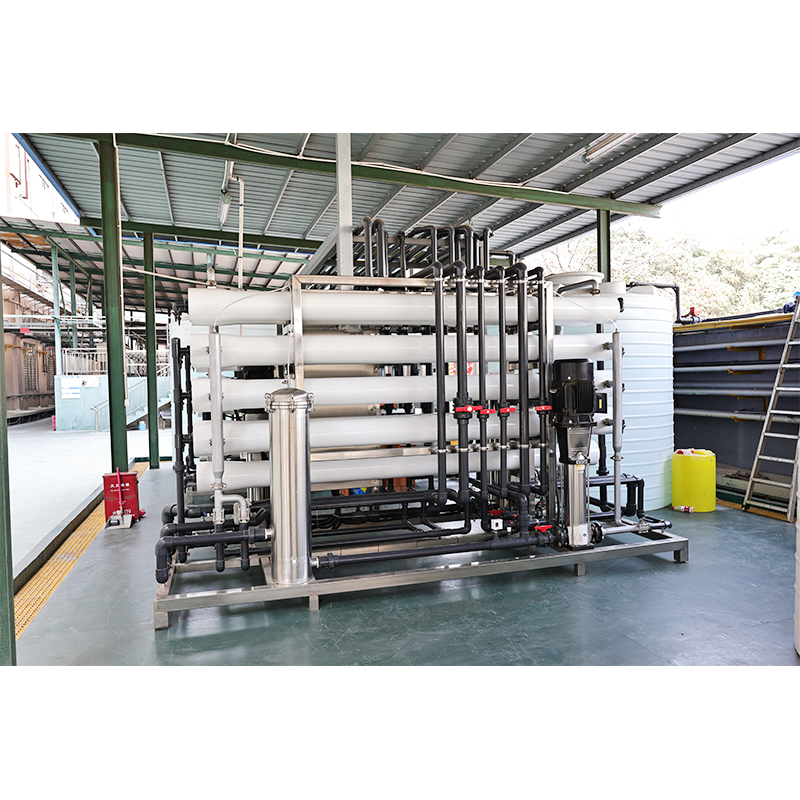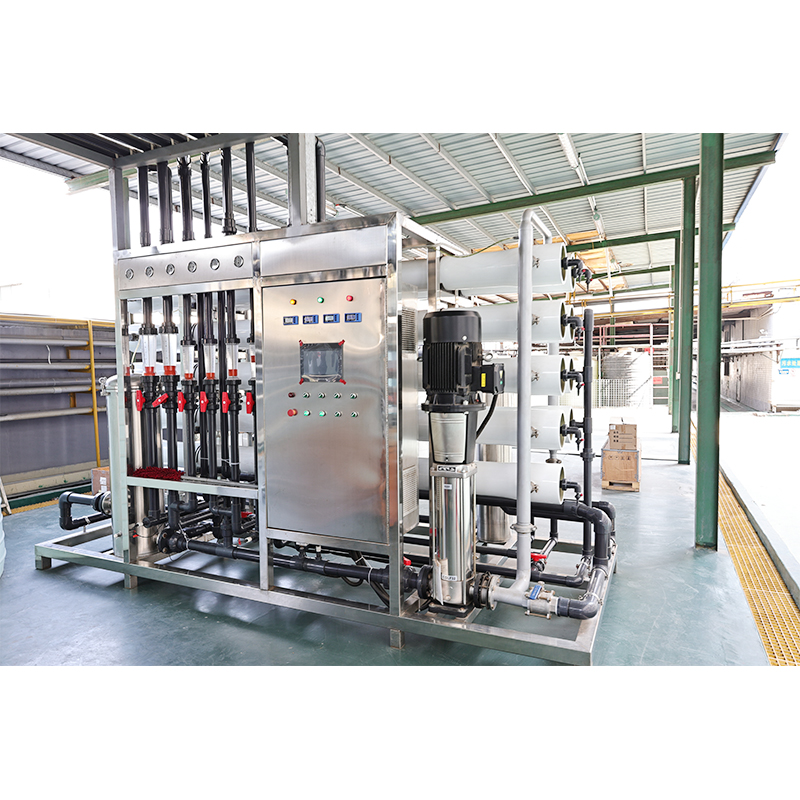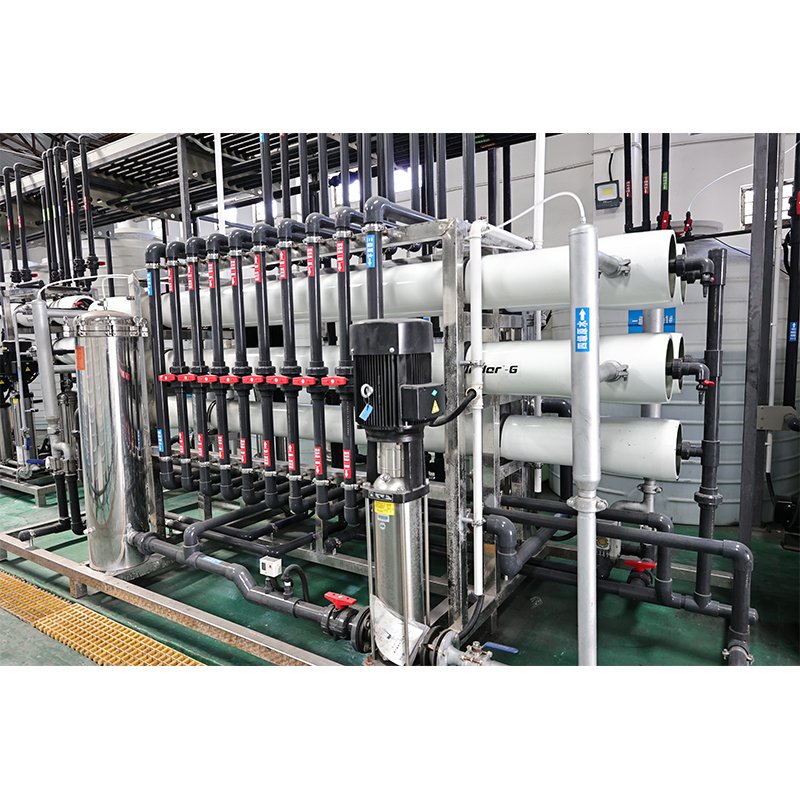9000LPH Nickel Ion Concentration Recovery And Water Reuse Equipment
9000LPH-
Treatment of copper-containing cleaning wastewater
1. Cleaning and sewage diversion of copper-containing cleaning wastewater
Step 1: Completely separate the concentrated waste liquid from the cleaning wastewater in the workshop. The treatment of concentrated wastewater is not considered in this plan.
Step 2: The copper-containing cleaning wastewater is collected and enters the collection bucket.
Step 3: The cleaning wastewater in the collection bucket enters the subsequent special membrane separation system after pre-filtration.
2. Special membrane separation system
Step 1: After pre-filtration, the copper-containing cleaning water enters the special membrane separation system, and is first pumped into the first-level T40 ion concentration membrane for preliminary separation. The fresh water after the first-level T40 concentration and separation is used as the raw water of the RO desalination system, and the concentrated water of T40 is used as the raw water of the second-level T27 concentration system.
Step 2: The fresh water of the RO deep desalination system is reused in the workshop, and the concentrated water enters the raw water tank of the first-level T40.
Step 3: The concentrated water of the second-level T27 enters the sewage treatment system, and the fresh water returns to the raw water tank of the first-level T40.
3. Introduction to the performance of the separation membrane
In terms of membrane selection, the concentration part uses Ni/CuT27, Ni/CuT40, and Ni/CuT100 modified concentration membranes, and the concentration part uses three-stage concentration.
Modified concentration membrane (YX-Ni/CuT27):
1) The modified concentration membrane is modified according to the original characteristics of RO membrane and nanofiltration membrane to modify the pore size and anti-pollution ability, the molecular weight cutoff of the modified membrane is between the reverse osmosis membrane and the nanofiltration membrane, about 100-2000Da. The modified membrane is a composite membrane, and its surface separation layer is composed of polyelectrolytes, so it has a certain retention rate for inorganic salts. There are two main types of modified membranes, Ni/CuT27 membrane and Ni/CuT40 membrane: ① The operating range of Ni/CuT40 membrane is between nanofiltration and reverse osmosis, and the retention rate of monovalent ions is about 20% to 70%, and the retention capacity of divalent ions is between 50%-98%. The removal rate of soluble low-valent ions is lower than that of high-valent ions. Ni/CuT40 membrane is generally used for the recovery and concentration of industrial valuable metals, and partially removes dissolved salts. It is used for the concentration and recovery of valuable precious metals in electroplating and electronic circuit board wastewater production. The operating pressure of Ni/CuT40 membrane is generally 3.5-30bar. ②The operating range of Ni/CuT27 membrane is between ultrafiltration and nanofiltration, with a monovalent ion retention rate of ≤1% and a divalent ion retention capacity of 70%-90%. There is almost no removal rate for soluble low-valent ions. Ni/CuT40 membrane is generally used for removal of landfill leachate, industrial sewage, organic matter and pigments in surface water, hardness in groundwater, separation and purification of monovalent ions and divalent ions, and partial removal of dissolved salts, and extraction and concentration of useful substances in food and pharmaceutical production. The operating pressure of N270 membrane is generally 3.0-30bar.
2) Currently, Ni/CuT40 membrane is mainly used for the concentration and metal recovery of double-glazed copper foil cleaning water, copper clad copper foil cleaning water, electroplated copper sulfate cleaning water, nickel sulfate cleaning water, trivalent chromium cleaning water, blue passivation cleaning water, and electronic circuit board primary copper and secondary copper cleaning water
3) Currently, Ni/CuT27 membrane is mainly used for pre-treatment cleaning wastewater organic matter concentration, food wastewater concentration, concentrated liquid salt separation and purification, chemical industry organic matter and salt separation, monovalent ion and divalent ion separation. Ni/CuT27 has a 100% retention rate for organic matter, a 98% retention rate for divalent ions, and an almost 0 retention rate for monovalent ions.
The key to the concentration process is the membrane. The requirements for membrane materials are: good film-forming properties, thermal stability, chemical stability, high mechanical strength, resistance to acid, alkali and microbial erosion, resistance to chlorine and other oxidizing substances, high water flux and high salt retention rate, and resistance to colloid and suspended solids pollution. Ni/CuT40 membrane is cheap and the membrane materials used are mostly aromatic and polyacid hydrogen asymmetric composite membranes. Ni/CuT40 concentration membrane consists of two parts: one part is a porous membrane that plays a supporting role, and its mechanism is screening, the other part is a thin layer of dense membrane that plays a separation role, and its separation mechanism can be explained by dissolution diffusion theory. For composite membranes, the materials and structures of the epidermis and support layers that play a separation role can be optimized respectively, and composite membranes with excellent performance can be obtained. The forms of membrane components include hollow fiber, roll type, plate and frame type, and tube type. Among them, hollow fiber and spiral membrane components have high packing density, low cost, and good fluid mechanics conditions in the components, however, these two types of membrane components have high manufacturing technology requirements, difficult sealing, poor anti-pollution ability during use, and high requirements for pretreatment of feed liquid. Although plate-and-frame and tubular membrane components are easy to clean and resistant to pollution, they have low packing density and high cost. Therefore, hollow fiber or spiral membrane components are mostly used in nanofiltration systems.
Our company has developed three modified concentration membranes based on the types and characteristics of wastewater, while retaining the original characteristics of nanofiltration membranes and RO. These are special membrane products that have significant effects on separation of metal ions and anti-pollution for reclaimed water reuse.
For general reverse osmosis membranes, the desalination rate is an important indicator of membrane separation performance, but for modified concentration membranes, the desalination rate alone cannot explain their separation performance. Sometimes the retention rate of modified concentration membranes for substances with larger molecular weight is lower than that for substances with smaller molecular weight. The filtration mechanism of modified concentration membranes is very complex. Since the modified concentration membrane technology is an emerging technology, our research on the mechanism of modified concentration membrane is still in the initial exploration stage, and there are few relevant literatures. However, since the modified concentration membrane is a branch of reverse osmosis, many phenomena can be explained by the mechanism model of reverse osmosis.
The filtration performance of the modified concentration membrane is also related to the charge of the membrane, the process of membrane manufacturing, etc. Different modified concentration membranes have different selective permeabilities to solutes, such as Ni/CuT27 for the separation of monovalent ions and divalent ions, solution purification, organic matter and salt separation, organic matter purification, and pharmaceutical purification. The actual separation performance of the modified concentration membrane is also related to the operating pressure, solution concentration, temperature, pH value and other conditions of the concentration process. For example, the permeation flux increases with the increase of operating pressure, and the retention rate decreases with the increase of solution concentration.

